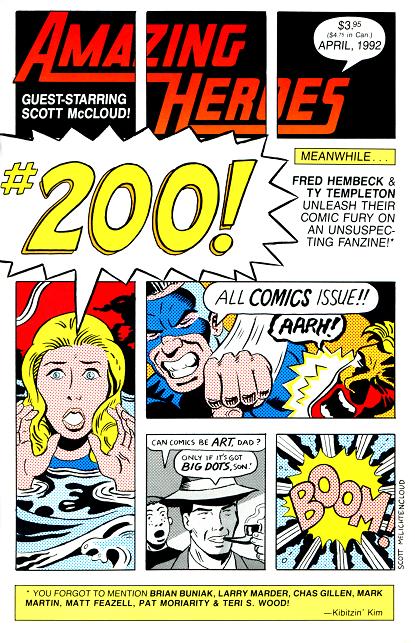
“Can comics be ART, dad? Only if it’s got BIG DOTS, son!”
That joke Scott McCloud put on the cover of Amazing Heroes #200 neatly shows the attitude of most comics fans to the occasional plundering of comics by the high art world: slightly amused, somewhat defensive but mostly irritated. To see Roy Lichtenstein get the credit, fame and fortune for swiping the work of other, largely anonymous artists is annoying, though I do think we can get a bit too defensive about it as comics fans, not an artform adverse to a bit of creative stealing itself. Nevertheless I can understand Scott Edelman’s annoyance at encountering a modern Lichtenstein repainting comic book pages panel by panel allegedly without crediting the original artists and passing it off as high art:
The intended market of buyers for these works of art would probably assume that the comics depicted in them sprang whole from the mind of the artist, and are a commentary on pop culture in general, rather than being line for line reproductions so close to the original comics that the artist might have been better served taking a photograph of the original comic book pages and framing that. Roy Lichtenstein, who I felt was profiteering on the work of great comics artists, at least altered them to suit his own style, as can be seen by this comparison plucked from David Barsalou’s site Desconstructing Roy Lichtenstein, which shows a Russ Heath panel side by side with Lichtenstein’s recreation.
I never looked at a Lichtenstein without feeling angry on behalf of the unnamed comics artists, because I always felt that a fraud was being perpetrated upon an ignorant audience, one that might assume he was making a commentary on the culture though the tropes of comics in general, as opposed to plundering specific artwork. (I believe any curator of an exhibit of Lichtenstein’s work who fails to include reproductions of the original panels falls down on his or her job.) But again, at least he made alterations to the original works, rather than passing along the unfiltered imagery of Joe Kubert, John Romita, and others as his own.
I’ve always shared Edelman’s feelings about Lichtenstein to some extent, though I do think that his artwork does have an intrisinct worth nonetheless that Shary Moody’s modern equivalent doesn’t have. The difference is one of cultural context.
Roy Lichtenstein’s paintings of blown-up comics panels were mostly made in the early sixties, before 1965. This was a time when comics still was largely anonymously made, mass produced junk culture which even the people making them for the most part didn’t consider art. This was when high and low culture were still taken seriously, before the rise and rise and rise of pop culture. Comics fandom was still in its infancy and there was nobody to champion comic books: Alter Ego started in 1961, the Batman tv series only happened in 1966, it was still a proud and lonely thing to be a comics fan. Comic books for all intents and purposes therefore were mass produced industrial artifacts of the throwaway consumer society, just like Warhol’s soup cans were. There was no way for Lichtenstein to credit the artists he was inspired by because nobody knew who they were. Even somebody like Kingsley Amis, openminded enough to champion science fiction, could only do so by offering it as a superior form of popular culture, rather than as part of literature in its own right.
But since then, with the rise of pop culture, the democratisation of the arts that brought along and the almost complete disappearance of the distinction between “high” and “low” forms of art, comics have become an artform in its own right. What’s more, thanks to the pionering work of those weirdos who always saw something more than disposable entertainment in them, its practitioners, like their counterparts in newspaper strips, magazine and even advertising illustration, have been de-anonymised, been identified and credited for their art. Which means that while Lichtenstein in 1963 could turn a Russ Heath panel from All-American Men of War into a painting and look genuinely innovative and progressive by repropositioning “low art” in a “high art” context, just looks lazy and downright insulting at best when done by Sharon Moody in 2011. It offers nothing new, it’s just passing off somebody else’s creative decisions as your own work by copying it. This is neither low nor high art; it’s bad art.
kevrob
January 26, 2014 at 9:42 amLichtenstein damned well knew who he was swiping from. He served under Irv Novick, the artist who drew the source panel from “Whaam!”, in the US Army in WWII.
All comics have and had indicia printed with the publisher’s address, and, at the time, info filed with the US Post Office for 2nd class mailing permits. Finding out who drew the originals, and getting permission to create a derivative of a copyrighted work was certainly possible. Any knowledgeable comics fan could have identified the penciller in question, and probably spotted the inker for you.
IF RL was ignorant of the source artists, it would have been on purpose.
Martin Wisse
January 26, 2014 at 4:40 pmI didn’t know that he served under Novick, that’s interesting. Where did you get this from?
I’m not sure whether it was really that easy to get the sources, but I do agree that Lichtenstein didn’t even try. Which is more or less my point: comics weren’t art, just disposable artifacts therefore you needn’t bother with getting permission…